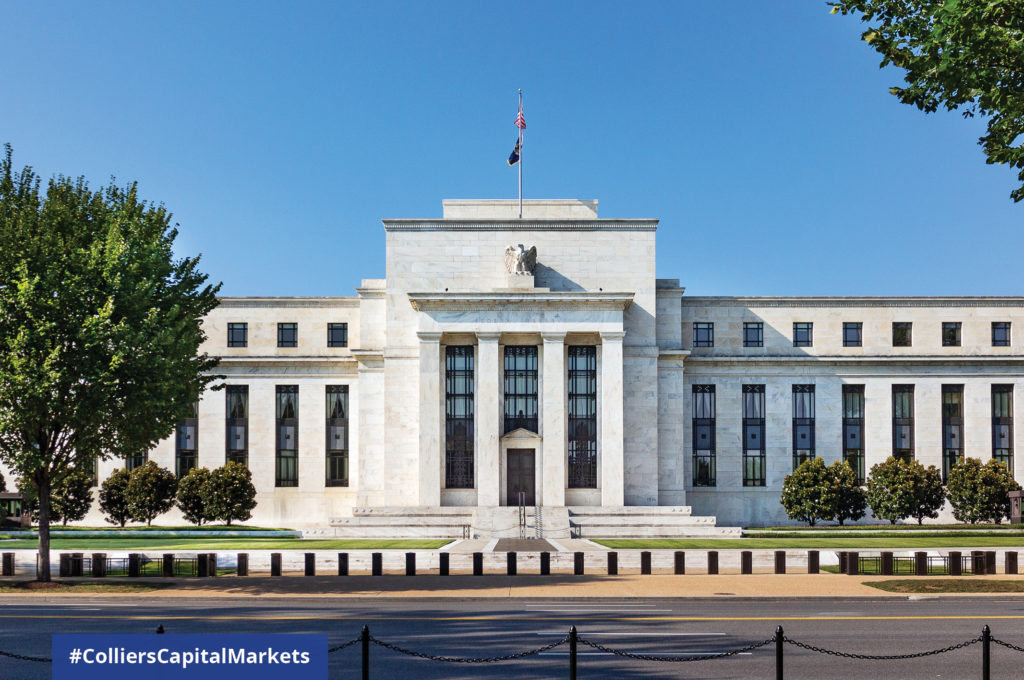Colliers Capital Markets recently spoke to Steig Seaward, National Director of Research, about recent Federal Reserve action and the outlook for the U.S. economy. Here are the takeaways.
Colliers Capital Markets (CCM): Why has the Fed been so aggressive with raising the Fed Funds Rate?
Steig Seaward (SS): Following a 50-basis-point increase in May and a 25-basis-point hike in March, the Federal Reserve raised its benchmark interest rate by 75 basis points in June, the most aggressive rate hike since 1994. It broke from its issued guidance of a 50-basis-point increase after May’s Consumer Price Index (CPI) report indicated that inflation reversed course and increased 30 basis points, to 8.6%. And shortly before the start of the June Fed meeting, the University of Michigan revealed that U.S. consumer sentiment had fallen to its lowest level ever. As a result, the Fed went on the offensive and bumped the rate by 75 basis points to calm the sharpest rise in inflation over the last four decades.
CCM: What’s next?
SS: With June’s CPI figure coming in above expectations at 9.1%, the Fed is widely expected to approve another 75-basis-point rate increase at its July meeting and to keep pressing on the gas at the September meeting. Fed Chairman Jerome Powell indicated that the Fed will remain aggressive until it begins to see “compelling evidence that inflation is moving down.” With inflation projected to decline in earnest later this year, the Fed could scale back its rate hikes to 25 basis points at the November and December meetings, finishing the year with the benchmark rate at 3.50%–3.75% and likely peaking at 3.75%–4.0% in early 2023. However, the market is recalibrating after June’s CPI announcement, so these expectations could change in the days ahead.
Fed Chairman Jerome Powell indicated that the Fed will remain aggressive until it begins to see “compelling evidence that inflation is moving down.”
CCM: The Fed is trying to orchestrate a soft landing. What’s the outlook on the economy?
SS: Oxford Economics projects real GDP growth slowing to around 2.3% in 2022 and decelerating to 1.3% in 2023. Moreover, it predicts that falling energy prices and easing supply chain stress on food and core goods will drop inflation to below 3% by mid-year 2023 and below 2% by the end of 2023. Housing remains a wildcard.
The Fed is attempting to thread a very fine line to tame inflation with minimal impact on employment and GDP growth, and a policy overshoot remains a concern. While the front-loaded policy tightening could raise the odds of a slide into a recession, that is not a foregone conclusion.
CCM: Recent movement in the 10-year Treasury suggests a market that believes recessionary risks are elevated, and that the Fed may reverse course and cut rates in 2023.
SS: That’s right. Treasury rates have fallen from a peak of nearly 3.5% in June, to around 3% today over concerns of future growth. But with a national unemployment rate of 3.6%, a monthly average of 457,000 new jobs added since the beginning of the year, and an expanding labor pool, the labor market remains very strong.
While persistent inflation will likely keep the Fed aggressive in the near term, with a robust labor market and healthy consumer demand, the nation could skirt a recession.
While persistent inflation with likely keep the Fed aggressive in the near term, with a robust labor market and healthy consumer demand, the nation could skirt a recession.

 Aaron Jodka
Aaron Jodka

 Nicole Larson
Nicole Larson
